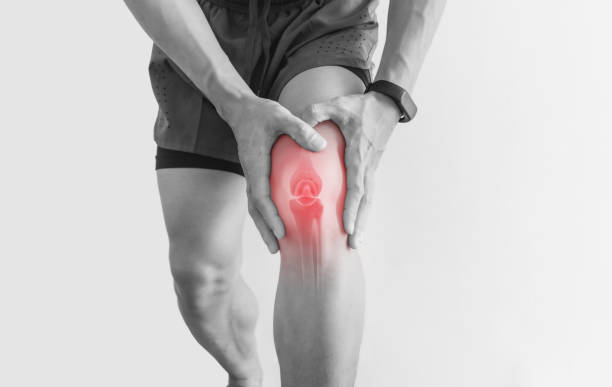Signs and Symptoms
Knee pain is usually accompanied with the following signs and
symptoms:
- Weakness or instability
- Popping or crunching noises
- Inability to bend and / or fully straighten the knee
- Swelling and Stiffness
- Limping due to discomfort
- Redness and warmth to the touch
- Tenderness around the joint line
- Associated hip and ankle pain
Risk Factors
- Old age
- Obesity
- Previous Sport injuries
- Genetics
Causes
Aging and repeated stress on the knee joint are the most common
causes, of knee
pain. Other common causes of knee pain include:
-
Acute knee injuries such as the torn meniscus, ligament injuries like ACL
injury, PCL injury, Medial and lateral
collateral ligament injuries
-
Arthritis- Osteoarthritis, Rheumatoid Arthritis, Psoriatic Arthritis Gout etc.
- Mechanical conditions, such as dislocated kneecap, hip or foot pain etc.
- Bursitis- Housemaid Knee, Pes Anserina Bursitis, Infrapatellar bursitis
- Fracture- Knee cap fracture or stress fracture in old age.
- Bone tumours
Treatment modalities for knee pain
Self-care measures, such as resting the knee, keeping it elevated, applying heat and cold packs can help in managing knee pain.
Depending on the cause and severity of pain, the following treatment options might be recommended:
- Medications: Painkillers and anti-inflammatory medications are recommended to manage the underlying conditions. NSAIDS, Muscle Relaxants, Opioid are often taken and prescribed for acute onset knee pain. Due to harmful effect of these medicines in long term like gastritis, renal dysfunction, liver dysfunction, they are to be avoided for long term and very harmful if taken without consulting your treating physicians.
- Physiotherapy: Some exercises are advised to help you regain full range of motion, strength, power, endurance and coordination of the knee movements. The most important point to be remembered is that if physiotherapy is done in acute onset pain , it may lead to exaggeration of your knee pain and hence these are advisable only when the pain subsides.
- Arthroscopic surgery– Sometimes patients are advised for arthroscopic surgeries which is done using an instrument called arthroscope.
- Intra-articular injections for knee pain– This therapy includes injecting certain medications directly into the knee joint to manage the pain and other symptoms. Examples include injections of corticosteroids, hyaluronic acid or other viscosupplements
-
Radiofrequency Ablation of the Genicular nerve for knee pain
Radiofrequency ablation of the genicular nerve is done by Pain specialist to
relieve knee pain in people who suffer from knee osteoarthritis . In patients whose pain does not subside with knee replacement surgeries have a last treatment option of undergoing radiofrequency ablation of genicular nerves providing immediate pain relief without any complications.
-
Regenerative approach for knee pain
If traditional methods fail to alleviate your knee pain, regenerative medicine could be a great option. Unfortunately, many of these patients opt for a surgical approach. Surgical treatments such as arthroscopy, subchondral bone drilling and knee replacement surgeries are often the last steps in the treatment cascade. Regenerative medicine options include:
- Platelet Rich Plasma Therapy: Platelets are rich source of growth factors which are capable of regenerating the torn and degenerated tissue. Small amount of blood is taken from your body and is processed in a specialized machine then the concentrated growth factors are injected into the torn tissues with the help of various machines which guide the doctor to reach the exact place of damage. This procedure is done as a day care procedure with no complications at all and is the best non surgical alternative to knee replacement surgery.
- Stem cell therapy: It is a minimally invasive procedure, in which healthy adult stem cells are injected into the knee joint. These stem cells have the potential to decrease inflammation and delay or avoid the need for knee replacement surgery
-
Prolotherapy: It is an injection technique to stimulate growth and healing in the damaged joints. The injection generally contains no drugs or steroids. A safe solution of glucose is injected into your knee joint, which acts as an irritant and stimulates your body’s defense and healing mechanisms.
Regenerative therapy is done to arrest the damage of knee in that particular stage and hence prevent further damage and avoid undergoing for replacement surgeries.
- Surgery– Knee replacement surgery is advised in last stages of the osteoarthritis. sometimes arthroscopic surgeries are suggested for ligament injuries.
Why Choose PANAX?
PANAX is one of the first multidisciplinary pain management center
offering
comprehensive non surgical pain management services.
All our Treatment are:
- Non surgical
- Takes less than a hour
- Painless
- No blood loss
Diagnosis
Physical examination – can establish the cause behind knee
pain.
Range of motion – during flexion(bending of nee joint) and
extension(straightening of knee joint)
Test for Ligament injuries
Comparing the functioning of the to your healthy knee.
Imaging tests, such as X-Rays, MRI Scan, CT Scan
Dynamic Ultrasound– This is the gold standard test to
identify the pain
generator and also the
stage of arthritis and it
is to be performed by a pain physician.
